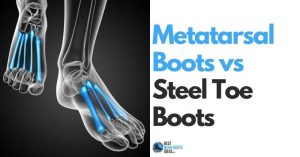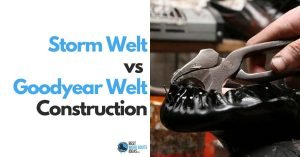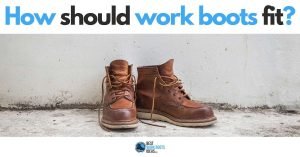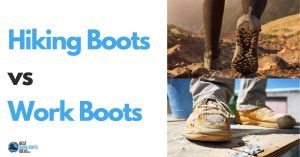Why Do Ironworkers Use Wedge Boots? Learn why this is the only footwear they wear
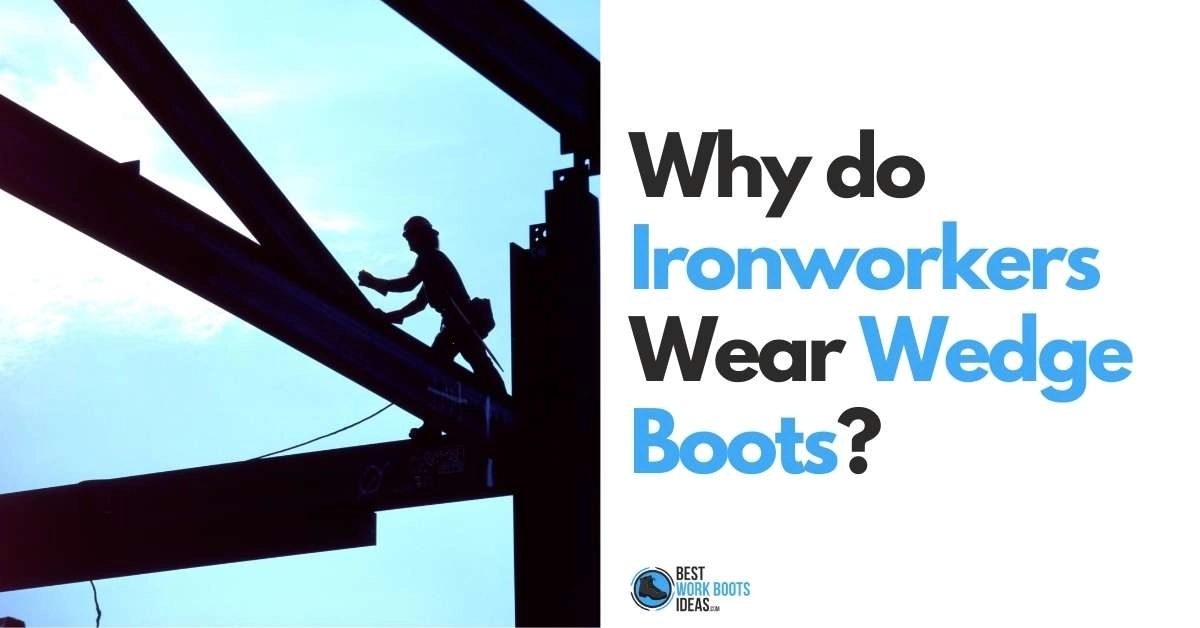
Maybe you knew, maybe it’s news to you, but ironworkers usually choose wedge boots as their style of work boot.
Today I’m going to get into the reasons why America’s Ironworkers want wedge boots on the job, and the benefits they provide. Let’s do it!
Contents
Protecting Souls with the Proper Soles: Why Ironworkers Use Wedge Sole Work Boots
Ironworkers use wedge boots because of flat outsoles that provide a firm grip on I-beams and other dangerous terrain. This style outsole delivers the slip- and oil-resistant peace of mind ironworkers need while working on bridges, highways, and skyscrapers.
The flat design of wedge outsoles (lack of a heel) also prevents the boot from getting hooked on any bolts or objects on steel beams.
When working in the places ironworkers do, this can be the difference between safety and health.
At times, it can even be the difference between life and death.
In addition to the shape and features found in wedge-style outsoles, the materials used to make them also provide great cushioning.
Ironworkers are on their feet all day, and usually don’t have the opportunities for breaks that most workers do.
When it’s tough, or even impossible, to step aside and take a break, you want boots that give your feet a break just by wearing them.
This is something that wedge boots do better than most work boots.
Finally, the flat outsole lacks a deep tread or lugs that would allow mud or debris getting stuck to or in it.
Something stuck in your boot tread will affect how your foot makes contact with your walking surface.
This might not matter for bricklayers or contractors, but 20, 40, or 80 stories into the air, traction and balance matters a WHOLE lot.
An unwanted passenger on your boot could turn you from a sure-footed ibex into a baby giraffe.
The last thing you want to worry about is slippery surfaces.
I can assure you, none of my ironworker friends in Local 11 want to make any choices that’ll make them clumsy
Excuse My Ignorance, but What’s a Wedge Boot?
Commonly known as “wedges,” or a “wedge sole work boot”, a wedge boot is a work boot with an outsole that runs the entire length of your foot.
The outsoles don’t “cut in” where your arch is, and there is no pronounced heel.
They’re made for greater cushioning, slip resistance, and shock resistance.
They also lack lugs or pronounced tread patterns.
This is in contrast to standard work boots or hiking boots which usually have a raised heel, deep lugs, and an overall focus on helping stay stable on irregular ground.
Besides the physical features, the consistency of the outsoles also make for an extremely flexible boot.
This is a feature that many workers want, but aren’t sure where to find.
Look no further, you’ll find it in a pair of wedges!
What’s an Ironworker?
Ironworkers are construction professionals that install, connect, and deconstruct the steel and iron beams that modern buildings and infrastructure is supported by.
You’ll find ironworkers on any big commercial or public construction project in your area.
It’s not all about skyscrapers and bridges however, there are many projects that wouldn’t be possible without the presence of skilled ironworkers.
A bulkhead for where the park meets the river? Ironworkers.
The Roller coasters at your local theme park? Ironworkers.
Don’t be confused by the use of the word “iron,” ironworkers deal with a variety of metals.
However, if we’re being honest, it’s probably most often steel.
The traditional imagery of ironworkers is the famous photo of 11 men casually having lunch while building Rockefeller Center in New York City.
Iron work of this type is still a big part of the industry, albeit with more safety harnesses, but it doesn’t represent everything ironworkers do.
Are Wedge Soles Made Differently Than Other Outsoles?
Yes. Wedges are made thin at the toe and get progressively thicker as they get to the heel.
They are usually made with shock-absorbing polyurethane materials that provide greater flexibility and bounce than traditional rubber outsole.
Safety Toe or No? Are Wedge Boots OSHA Approved?
Yes, if you get the right pair!
OSHA usually approves boots based on whether or not they have an ASTM-rated toe cap.
There are plenty of manufactures that make wedge boots with safety toes, so you’ll be up to code in a pair of wedges.
In their American Heritage range, the Thorogood Boot company have composite toe and steel toe protection available.
In addition other features also include a fiberglass shank, cushioned insole for comfort and joined together by Goodyear storm welt construction.
You can pretty much get whatever style and feature you like. The wedge sole shouldn’t really make a difference.
What Are Wedge Boots Good For? Trades That Use Wedge Boots
Wedges are used by trade, service and industrial workers that work on smooth surfaces.
Factory workers, ironworkers, or anyone that spends their work day on flat, man-made floors could benefit from wedge boots.
Because the majority of the outsole is making contact with the ground, smooth surfaces like metal, cement, and tile suit wedge boots best.
Add the slip- and oil- resistance found in most wedge boots, and you couldn’t be better served by another pair.
But wait, there’s more!
The excellent shock absorption offered by most wedge boots make these good for delivery drivers, warehouse workers and movers.
If you’re on solid ground, do a lot of stepping down, and are frequently carrying a lot of weight, wedges will work best.
Even some trades that are entirely outdoors are suited for a pair of wedges.
Jobs like asphalt laying are physically demanding, but there’s also a delicate nature to it.
The even surfaces of wedges evenly distribute weight so asphalt workers don’t leave marks in freshly laid surfaces.
Know Your Limitations: Occupations That Should Avoid Wedge Boots
Any workers that spend their time outdoors or on rough terrain should avoid wedge boots.
Jobs like this are better served by footwear with deep lug patterns that will help the person wearing them get a better grip.
Landscapers, linemen and loggers are just a few of the professions that come to mind when considering who’s poorly served by wedge-style footwear.
The relatively smooth surface of a wedge outsole won’t stabilize the wearer when they’re on wet grass, or the side of a mountain.
With linemen, it’s almost certain that your feet will slip out of their climbing gaffs within the first couple minutes.
This is an example of how choosing the proper boot for your work is more important than people often think.
Boots can be a fashion statement and in recent years that’s more true than ever.
Even with that in mind, your first priority always has to be seeing your boots as a tool meant to help you get the job done.
Hopefully that not only answers your question but also gives you a bit more of insight into why Ironworkers wear wedge boots.


![Are Steel Toe Boots Good for Motorcycle Riding [featured image]](https://www.bestworkbootsideas.com/wp-content/uploads/2022/02/are-steel-toe-boots-good-for-motorcycle-riding-featured-image-300x157.jpg)
